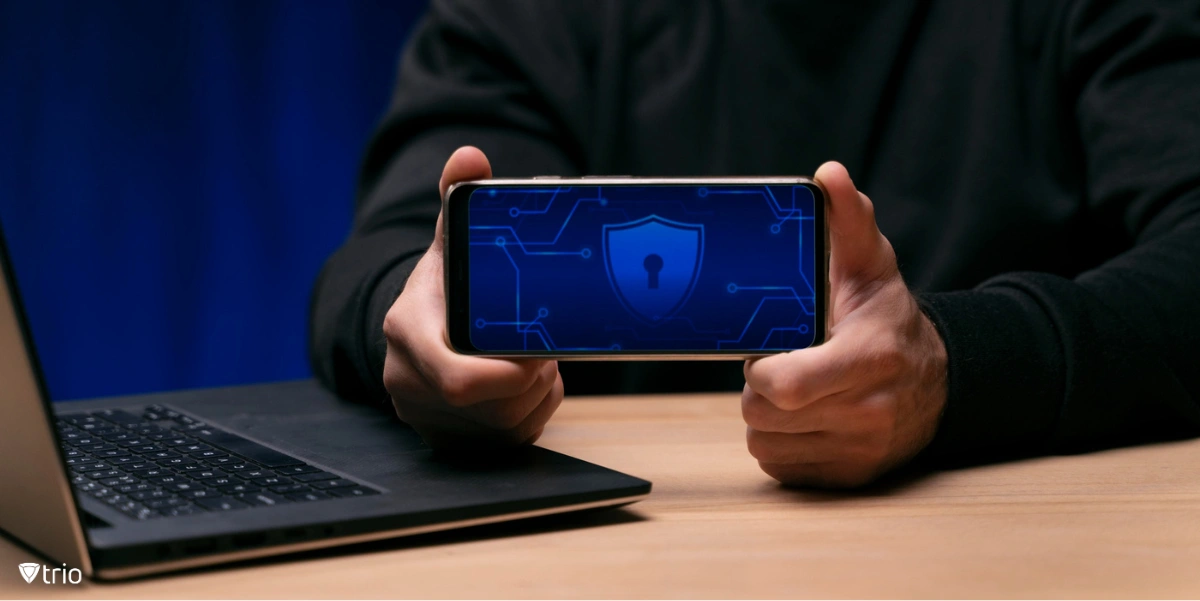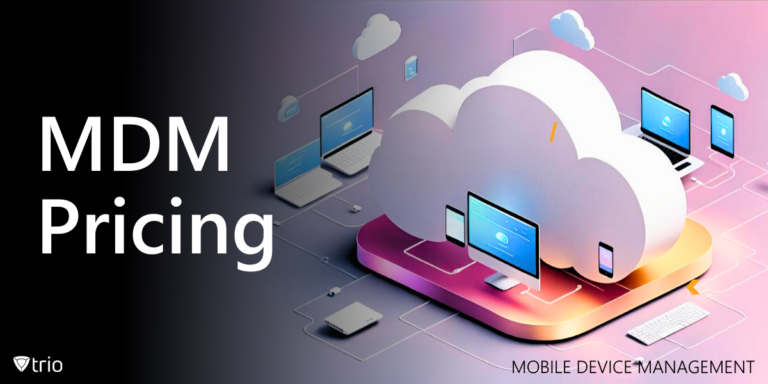In the digital realm, Mobile Threat Defense (MTD) stands as a formidable guardian against the myriad of threats targeting our indispensable companions: mobile devices. At its core, MTD embodies a comprehensive suite of technologies and practices designed to protect these devices from spyware, network attacks, and other cybersecurity threats.
In the realm of IT risk management, the significance of MTD cannot be overstated. As our reliance on mobile devices escalates, so does the sophistication of attacks aimed at exploiting them. From sensitive business emails to personal financial transactions, our mobile devices are full of valuable information, making them attractive targets for cybercriminals. Hence, implementing a robust Mobile Threat Defense strategy is not merely an option but a necessity for safeguarding our digital lives against the ever-evolving threats.
The Growing Need for MTD
The escalation of mobile threats is alarming. Let’s take a look at some of the data regarding these threats.
The Surge in Mobile Threats
In the third quarter of 2023 alone, over 8.3 million instances of mobile malware, adware, and riskware attacks were thwarted. Adware, representing 52% of these threats, emerged as the predominant menace to mobile devices. Additionally, according to SecureList, there was a significant discovery of malicious installation packages, amounting to 438,962.

Impacts on Businesses and Individuals
Mobile threats have a profound impact on both businesses and individuals. The vulnerability of mobile devices has made them prime targets for cybercriminals, posing a risk not just to personal information but also to corporate data. The Zimperium 2023 Global Mobile Threat Report reveals an increasing trend in mobile malware variants and phishing attacks that exploit the ubiquity and vulnerabilities of mobile devices. Notably, 60% of endpoints accessing enterprise assets are now mobile devices, highlighting the imperative need for reinforced mobile security measures.
Real-World Breaches: A Wake-Up Call
Studies of recent security breaches further illuminate the dire need for mobile threat protection. For instance, malicious apps discovered on reputable platforms like Google Play, including a disguised PDF viewer that downloaded banking Trojans onto users’ devices, showcase the cunning tactics employed by attackers. These apps not only bypass platform security measures but also dupe users into compromising their own security.
Key Components of MTD Solutions
In navigating through the complex landscape of mobile security, understanding the foundational elements of MTD solutions illuminates the path to comprehensive protection.
Threat Detection: The First Line of Defense
At the heart of Mobile Threat Defense (MTD) solutions lies the capability for early detection of potential threats and vulnerabilities. This involves vigilantly scanning for network attacks, phishing attempts, and signs of malware that could compromise mobile devices. By leveraging advanced algorithms and threat intelligence, MTD systems excel in identifying these dangers early.
Building a Robust Threat Defense
Once a potential threat is identified, the next step is defending against it. This includes implementing mechanisms, such as firewalls, designed to protect against network attacks, malicious software, and phishing schemes. Through real-time monitoring and automated defense systems, MTD solutions block these threats before they can do harm. Encryption, secure connections, and application controls are among the tools employed to fortify the security of mobile devices.
Incident Response: Rapid Recovery and Mitigation
Effective MTD solutions go beyond just detecting and remediating threats; they also include comprehensive incident response capabilities. In the event of a security breach, having a predefined plan for mitigating damage and recovering from the incident is crucial. This might involve isolating affected devices, eradicating the threat, and restoring data from backups. The goal is to minimize downtime and ensure continuity of operations.
Seamless Integration with Existing Security Frameworks
For maximum effectiveness, MTD solutions must integrate seamlessly with an organization’s existing security frameworks. This integration enhances the overall security posture by providing a unified approach to managing and protecting against threats across all devices, networks, and applications. It allows for centralized management, simplifies compliance efforts, and ensures that security policies are consistently applied across the board.
Choosing the Right MTD Solution for Your Business
Selecting the ideal MTD solution for your organization requires careful consideration of several factors. Compatibility with your current systems, scalability to grow alongside your business, and ease of use for both IT staff and end-users are paramount. These aspects ensure the seamless integration and long-term viability of the chosen solution.
When comparing leading MTD solutions, it’s essential to scrutinize how each addresses the security risks prevalent in today’s mobile-centric work environment. Solutions vary in their approach to providing MTD protection, with some focusing on network security, while others prioritize app and device-level defenses. The best security solutions offer comprehensive coverage that spans the entirety of enterprise mobility, ensuring that all aspects of your mobile ecosystem are shielded against threats.
Best Practices for Maximizing MTD Effectiveness
Incorporating these best practices into your organization’s mobile threat defense solutions can significantly enhance the effectiveness of MTD solutions.
Regularly Updating and Patching Mobile Operating Systems and Applications
One of the simplest yet most effective measures to enhance mobile security is regularly updating and patching mobile operating systems and applications. These updates are crucial for closing security holes and adding new functionalities to protect against cyber threats. As cyber threats evolve, operating system providers frequently release updates to counteract new types of attacks. Failing to update leaves devices vulnerable to information loss, identity theft, and financial fraud. Organizations should utilize tools to monitor and ensure the up-to-dateness of devices and applications across their mobile fleet, emphasizing the mitigation of data breach risks.
Educating Employees on Mobile Security Best Practices
Education plays a pivotal role in strengthening an organization’s security posture. Informing employees about the significance of security updates and teaching them how to recognize and avoid potential threats are fundamental steps. As the tactics of cyber attackers constantly evolve, so should the strategies for defense. Incorporating education on security protocols, including the importance of regular updates, can significantly reduce the risk of unauthorized data access.

Conducting Regular Security Assessments and Audits
To effectively manage and mitigate security risks, conducting regular security assessments and audits is essential. These assessments help identify vulnerabilities within the mobile infrastructure, allowing for the timely implementation of corrective measures. They serve as an opportunity to review and enhance existing security protocols and ensure that all managed devices adhere to the organization’s security standards.
Creating a Comprehensive Mobile Security Policy
Developing a comprehensive mobile security policy that encompasses threat detection, incident response, and the management of network traffic is crucial. This policy should be tailored to the organization’s specific needs, addressing the management of devices, networks, and applications. Utilizing machine learning and other advanced technologies can significantly aid security teams in efficiently detecting threats and responding to them swiftly. A well-defined policy aids in the coherent coordination of security efforts, ensuring a unified defense mechanism against potential threats.
Integrating MTD with Mobile Device Management (MDM) Solutions
The digital workspace has evolved rapidly, with mobile devices becoming central to business operations. This shift necessitates robust security measures to protect against sophisticated threats. However, MTD’s efficacy is significantly enhanced when integrated with Mobile Device Management (MDM) solutions.
MDM solutions serve as the backbone for managing mobile devices within an organization, focusing on device configuration, compliance enforcement, and application management. However, by integrating MTD capabilities, organizations can extend their defense perimeter to include proactive threat detection, automated response mechanisms, and in-depth analysis of potential vulnerabilities. This combination ensures not only the management of mobile devices but also their security against advanced threats.
Moreover, Mobile Application Management (MAM) features within MDM solutions are complemented by MTD’s ability to scrutinize apps for malicious behavior, ensuring that only safe and vetted applications are allowed on managed devices. This synergy between MTD and MDM creates a comprehensive security and management framework that is greater than the sum of its parts.
We invite you to explore Trio’s MDM solutions, which seamlessly integrate with MTD capabilities. Trio is designed to provide not just control over mobile devices but also a robust defense against the ever-evolving landscape of mobile threats. Together, MTD and MDM form the cornerstone of a secure, efficient, and resilient mobile device ecosystem within your organization. Download your free demo today!
Conclusion
In our exploration of Mobile Threat Defense (MTD), we’ve unveiled the pivotal role it plays in safeguarding our mobile ecosystems. As cyber threats evolve, so too must our defenses. MTD offers a comprehensive approach to detect and neutralize threats, ensuring that both personal and corporate data remain secure. It is an indispensable ally in the quest for digital security.
See Trio in Action: Get Your Free Trial Now!
We encourage organizations to regularly assess and enhance their mobile security posture. Incorporating MTD into your cybersecurity strategy not only fortifies your defenses but also prepares you for the complexities of the digital future. Remember, in the realm of cybersecurity, being proactive is not just advisable—it’s imperative.
Get Ahead of the Curve
Every organization today needs a solution to automate time-consuming tasks and strengthen security.
Without the right tools, manual processes drain resources and leave gaps in protection. Trio MDM is designed to solve this problem, automating key tasks, boosting security, and ensuring compliance with ease.
Don't let inefficiencies hold you back. Learn how Trio MDM can revolutionize your IT operations or request a free trial today!




